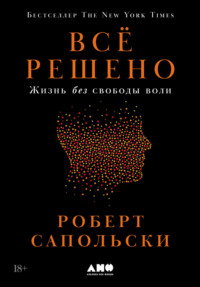
Полная версия
Биология добра и зла. Как наука объясняет наши поступки
350
S. Lupien et al., “Effects of Stress Throughout the Lifespan on the Brain, Behaviour and Cognition,” Nat Rev Nsci 10 (2009): 434; V. Carrion et al., “Stress Predicts Brain Changes in Children: A Pilot Longitudinal Study on Youth Stress, Posttraumatic Stress Disorder, and the Hippocampus,” Pediatrics 119 (2007): 509; F. L. Woon and D. W. Hedges, “Hippocampal and Amygdala Volumes in Children and Adults with Childhood Maltreatment – Related Posttraumatic Stress Disorder: A Meta-analysis,” Hippocampus 18 (2008): 729.
351
S. J. Lupien et al., “Effects of Stress Throughout the Lifespan on the Brain, Behaviour and Cognition,” Nat Rev Nsci 10 (2009): 434; D. Hackman et al., “Socioeconomic Status and the Brain: Mechanistic Insights from Human and Animal Research,” Nat Rev Nsci 11 (2010): 651; M. Sheridan et al., “The Impact of Social Disparity on Prefrontal Function in Childhood,” PLoS ONE 7 (2012): e35744; J. L. Hanson et al., “Structural Variations in Prefrontal Cortex Mediate the Relationship Between Early Childhood Stress and Spatial Working Memory,” J Nsci 32 (2012): 7917; M. Sweitzer et al., “Polymorphic Variation in the Dopamine D4 Receptor Predicts Delay Discounting as a Function of Childhood Socioeconomic Status: Evidence for Differential Susceptibility,” SCAN 8 (2013): 499; E. Tucker-Drob et al., “Emergence of a Gene X Socioeconomic Status Interaction on Infant Mental Ability Between 10 Months and 2 Years,” Psych Sci 22 (2011): 125; I. Liberzon et al., “Childhood Poverty Alters Emotional Regulation in Adulthood,” SCAN 10 (2015): 1596; K. G. Noble et al., “Family Income, Parental Education and Brain Structure in Children and Adolescents,” Nat Nsci 18 (2015): 773.
352
К сноске: R. Nevin, “Understanding International Crime Trends: The Legacy of Preschool Lead Exposure,” Environmental Res 104 (2007): 315.
353
Reviewed in R. Sapolsky, Why Zebras Don’t Get Ulcers: A Guide to Stress, Stress-Related Diseases and Coping, 3rd ed. (New York: Holt, 2004). Как это происходит у павианов: P. O. Onyango et al., “Persistence of Maternal Effects in Baboons: Mother’s Dominance Rank at Son’s Conception Predicts Stress Hormone Levels in Subadult Males,” Horm Behav 54 (2008): 319.
354
F. L. Woon and D. W. Hedges, “Hippocampal and Amygdala Volumes in Children and Adults with Childhood Maltreatment – Related Posttraumatic Stress Disorder: A Meta-analysis,” Hippocampus 18 (2008): 729; D. Gee et al., “Early Developmental Emergence of Human Amygdala-PFC Connectivity After Maternal Deprivation,” PNAS 110 (2013): 15638; A. K. Olsavsky et al., “Indiscriminate Amygdala Response to Mothers and Strangers After Early Maternal Deprivation,” BP 74 (2013): 853.
355
L. M. Oswald et al., “History of Childhood Adversity Is Positively Associated with Ventral Striatal Dopamine ® Responses to Amphetamine,” Psychopharmacology (Berlin) 23 (2014): 2417; E. Hensleigh and L. M. Pritchard, “Maternal Separation Increases Methamphetamine-Induced Damage in the Striatum in Male, But Not Female Rats,” BBS 295 (2014): 3; A. N. Karkhanis et al., “Social Isolation Rearing Increases Nucleus Accumbens Dopamine and Norepinephrine Responses to Acute Ethanol in Adulthood,” Alcohol: Clin Exp Res 38 (2014): 2770.
356
C. Anacker et al., “Early Life Adversity and the Epigenetic Programming of Hypothalamic-Pituitary-Adrenal Function,” Dialogues in Clin Nsci 16 (2014): 321.
357
S. L. Buka et al., “Youth Exposure to Violence: Prevalence, Risks, and Consequences,” Am J Orthopsychiatry 71 (2001): 298; M. B. Selner-O’Hagan et al., “Assessing Exposure to Violence in Urban Youth,” J Child Psych and Psychiatry 39 (1998): 215; P. T. Sharkey et al., “The Effect of Local Violence on Children’s Attention and Impulse Control,” Am J Public Health 102 (2012): 2287; J. B. Bingenheimer et al., “Firearm Violence Exposure and Serious Violent Behavior,” Sci 308 (2005): 1323. К сноске: I. Shaley et al., “Exposure to Violence During Childhood Is Associated with Telomere Erosion from 5 to 10 Years of Age: A Longitudinal Study,” Mol Psychiatry 18 (2013): 576.
358
Прекрасный развернутый обзор: L. Huesmann and L. Taylor, “The Role of Media Violence in Violent Behavior,” Ann Rev of Public Health 27 (2006): 393. See also J. D. Johnson et al., “Differential Gender Effects of Exposure to Rap Music on African American Adolescents’ Acceptance of Teen Dating Violence,” Sex Roles 33 (1995): 597; J. Johnson et al., “Television Viewing and Aggressive Behavior During Adolescence and Adulthood,” Sci 295 (2002): 2468; J. Savage and C. Yancey, “The Effects of Media Violence Exposure on Criminal Aggression: A Meta-analysis,” Criminal Justice and Behav 35 (2008): 772; C. Anderson et al., “Violent Video Game Effects on Aggression, Empathy, and Prosocial Behavior in Eastern and Western Countries: A Metaanalytic Review,” Psych Bull 136, 151; C. J. Ferguson, “Evidence for Publication Bias in Video Game Violence Effects Literature: A Meta-analytic Review,” Aggression and Violent Behavior 12 (2007): 470; C. Ferguson, “The Good, the Bad and the Ugly: A Meta-analytic Review of Positive and Negative Effects of Violent Video Games,” Psychiatric Quarterly 78 (2007): 309.
359
W. Copeland et al., “Adult Psychiatric Outcomes of Bullying and Being Bullied by Peers in Childhood and Adolescence,” JAMA Psychiatry 70 (2013): 419; S. Woods and E. White, “The Association Between Bullying Behaviour, Arousal Levels and Behaviour Problems,” J Adolescence 28 (2005): 381; D. Jolliffe and D. P. Farrington, “Examining the Relationship Between Low Empathy and Bullying,” Aggressive Behav 32 (2006): 540; G. Gini, “Social Cognition and Moral Cognition in Bullying: What’s Wrong?” Aggressive Behav 32 (2006): 528; S. Shakoor et al., “A Prospective Longitudinal Study of Children’s Theory of Mind and Adolescent Involvement in Bullying,” J Child Psych and Psychiatry 53 (2012): 254.
360
J. D. Unenever, “Bullies, Aggressive Victims, and Victims: Are They Distinct Groups?” Aggressive Behav 31 (2005): 153; D. P. Farrington and M. M. Tofi, “Bullying as a Predictor of Offending, Violence and Later Life Outcomes,” Criminal Behaviour and Mental Health 21 (2011): 90; M. Tofi et al., “The Predictive Efficiency of School Bullying Versus Later Offending: A Systematic/ Meta-analytic Review of Longitudinal Studies,” Criminal Behaviour and Mental Health 21 (2011): 80; T. R. Nansel et al., “Cross-National Consistency in the Relationship Between Bullying Behaviors and Psychosocial Adjustment,” Arch Pediatrics & Adolescent Med 158 (2004): 730; J. A. Stein et al., “Adolescent Male Bullies, Victims, and Bully-Victims: A Comparison of Psychosocial and Behavioral Characteristics,” J Pediatric Psych 32 (2007): 273; P. W. Jansen et al., “Prevalence of Bullying and Victimization Among Children in Early Elementary School: Do Family and School Neighbourhood Socioeconomic Status Matter?” BMC Public Health 12 (2012): 494; A. Sourander et al., “What Is the Early Adulthood Outcome of Boys Who Bully or Are Bullied in Childhood? The Finnish ‘From a Boy to a Man’ Study,” Pediatrics 120 (August 2007): 397; A. Sourander et al., “Childhood Bullies and Victims and Their Risk of Criminality in Late Adolescence,” Arch Pediatrics & Adolescent Med 161 (2007): 546; C. Winsper et al., “Involvement in Bullying and Suicide-Related Behavior at 11 Years: A Prospective Birth Cohort Study,” J the Am Academy of Child and Adolescent Psychiatry 51 (2012): 271; F. Elgar et al., “Income Inequality and School Bullying: Multilevel Study of Adolescents in 37 Countries,” J Adolescent Health 45 (2009): 351.
361
G. M. Glew et al., “Bullying, Psychosocial Adjustment, and Academic Performance in Elementary School,” Arch Pediatrics & Adolescent Med 159 (2005): 1026.
362
K. Appleyard et al., “When More Is Not Better: The Role of Cumulative Risk in Child Behavior Outcomes,” J Child Psych and Psychiatry 46 (2005): 235.
363
M. Sheridan et al., “Variation in Neural Development as a Result of Exposure to Institutionalization Early in Childhood,” PNAS 109 (2012): 12927; M. Carlson and F. Earis, “Psychological and Neuroendocrinological Sequelae of Early Social Deprivation in Institutionalized Children in Romania,” ANYAS 15 (1997): 419; N. Tottenham, “Human Amygdala Development in the Absence of Species-Expected Caregiving,” Developmental Psychobiology 54 (2012): 598; M. A. Mehta et al., “Amygdala, Hippocampal and Corpus Callosum Size Following Severe Early Institutional Deprivation: The English and Romanian Adoptees Study Pilot,” J Child Psych and Psychiatry 50 (2009): 943; N. Tottenham et al., “Prolonged Institutional Rearing Is Associated with Atypically Large Amygdala Volume and Difficulties in Emotion Regulation,” Developmental Sci 13 (2010): 46; M. M. Loman et al., “The Effect of Early Deprivation on Executive Attention in Middle Childhood,” J Child Psych and Psychiatry 54 (2012): 37; T. Eluvathingal et al., “Abnormal Brain Connectivity in Children After Early Severe Socioemotional Deprivation: A Diffusion Tensor Imaging Study,” Pediatrics 117 (2006): 2093; H. T. Chugani et al., “Local Brain Functional Activity Following Early Deprivation: A Study of Postinstitutionalized Romanian Orphans,” Neuroimage 14 (2001): 1290.
364
Ее идеи изящно подытожены в работе: M. Small, Our Babies, Ourselves (New York: Anchor Books, 1999).
365
H. Arendt, The Origins of Totalitarianism (New York: Harcourt 1951); T. Adorno et al., The Authoritarian Personality (New York: Harper & Row, 1950).
366
D. Baumrind, “Child Care Practices Anteceding Three Patterns of Preschool Behavior,” Genetic Psych Monographs 75 (1967): 43.
367
E. E. Maccoby and J. A. Martin, “Socialization in the Context of the Family: Parent-Child Interaction,” in Handbook of Child Psychology, ed. P. Mussen (New York: Wiley, 1983).
368
J. R. Harris, The Nurture Assumption: Why Children Turn Out the Way They Do (New York: Simon & Schuster, 1998).
369
J. Huizinga, Homo Ludens: A Study of the Play-Element in Culture (London: Routledge & Kegan Paul, 1938); A. Berghänel et al., “Locomotor Play Drives Motor Skill Acquisition at the Expense of Growth: A Life History Trade-off,” Sci Advances 1 (2015): 1; J. Panksepp and W. W. Beatty, “Social Deprivation and Play in Rats,” Behav and Neural Biol 39 (1980): 197; M. Bekoff and J. A. Byers, Animal Play: Evolutionary, Comparative, and Ecological Perspectives (Cambridge: Cambridge University Press, 1998); M. Spinka et al., “Mammalian Play: Training for the Unexpected,” Quarterly Rev of Biol 76 (2001): 141.
370
S. M. Pellis, “Sex Differences in Play Fighting Revisited: Traditional and Nontraditional Mechanisms of Sexual Differentiation in Rats,” Arch Sexual Behav 31 (2002): 17; B. Knutson et al., “Ultrasonic Vocalizations as Indices of Affective States in Rats,” Psych Bull 128 (2002): 961; Y. Delville et al., “Development of Aggression,” in Biology of Aggression, ed. R. Nelson (Oxford: Oxford University Press, 2005).
371
J. Tsai, “Ideal Affect: Cultural Causes and Behavioral Consequences,” Perspectives on Psych Sci 2 (2007): 242; S. Kitayama and A. Uskul, “Culture, Mind, and the Brain: Current Evidence and Future Directions,” Ann Rev of Psych 62 (2011): 419.
372
C. Kobayashi et al., “Cultural and Linguistic Influence on Neural Bases of ‘Theory of Mind’: An fMRI Study with Japanese Bilinguals,” Brain and Language 98 (2006): 210; C. Lewis et al., “Social Influences on False Belief Access: Specific Sibling Influences or General Apprenticeship?” Child Development 67 (1996): 2930; J. Perner et al., “Theory of Mind Is Contagious: You Catch It from Your Sibs,” Child Development 65 (1994): 1228; D. Liu et al., “Theory of Mind Development in Chinese Children: A Meta-analysis of False-Belief Understanding Across Cultures and Languages,” Developmental Psych 44 (2008): 523.
373
C. Anderson et al., “Violent Video Game Effects on Aggression, Empathy, and Prosocial Behavior in Eastern and Western Countries: A Meta-analytic Review,” Psych Bull 136 (2010): 151.
374
R. E. Nisbett and D. Cohen, Culture of Honor: The Psychology of Violence in the South (Boulder, CO: Westview Press, 1996).
375
A. Kusserow, “De-homogenizing American Individualism: Socializing Hard and Soft Individualism in Manhattan and Queens,” Ethos 27 (1999): 210.
376
S. Ullal-Gupta et al., “linkhing Prenatal Experience to the Emerging Musical Mind,” Front Systems Nsci 3 (2013): 48.
377
A. DeCasper and W. Fifer, “Of Human Bonding: Newborns Prefer Their Mothers’ Voices,” Sci 6 (1980): 208; A. J. DeCasper and P. A. Prescott, “Human Newborns’ Perception of Male Voices: Preference, Discrimination, and Reinforcing Value,” Developmental Psychobiology 17 (1984): 481; B. Mampe et al., “Newborns’ Cry Melody Is Shaped by Their Native Language,” Curr Biol 19 (2009): 1994; A. DeCasper and M. Spence, “Prenatal Maternal Speech Influences Newborns’ Perception of Speech Sounds,” Infant Behav and Development 9 (1986): 133.
378
J. P. Lecanuet et al., “Fetal Perception and Discrimination of Speech Stimuli: Demonstration by Cardiac Reactivity: Preliminary Results,” Comptes rendus de l’Académie des sciences III 305 (1987): 161; J. P. Lecanuet et al., “Fetal Discrimination of Low-Pitched Musical Notes,” Developmental Psychobiology 36 (2000): 29; C. Granier-Deferre et al., “A Melodic Contour Repeatedly Experienced by Human Near-Term Fetuses Elicits a Profound Cardiac Reaction One Month After Birth,” PLoS ONE 23 (2011): e17304.
379
G. Kolata, “Studying Learning in the Womb,” Sci 225 (1984): 302; A. J. DeCasper and M. J. Spence, “Prenatal Maternal Speech Influences Newborns’ Perception of Speech Sounds,” Infant Behav and Development 9 (1986): 133.
380
P. Y. Wang et al., “Müllerian Inhibiting Substance Contributes to Sex-linkhed Biases in the Brain and Behavior,” PNAS 106 (2009): 7203; S. Baron-Cohen et al., “Sex Differences in the Brain: Implications for Explaining Autism,” Sci 310 (2005): 819.
381
R. Goy and B. McEwen, Sexual Differentiation of the Brain (Cambridge, MA: MIT Press, 1980).
382
J. Money, “Sex Hormones and Other Variables in Human Eroticism,” in Sex and Internal Secretions, ed. W. C. Young, 3rd ed. (Baltimore: Williams and Wilkins, 1963), p. 138.
383
G. M. Alexander and M. Hines, “Sex Differences in Response to Children’s Toys in Nonhuman Primates (Cercopithecus aethiops sabaeus),” EHB 23 (2002): 467 (рисунок в тексте из этого источника). J. M. Hassett et al., “Sex Differences in Rhesus Monkey Toy Preferences Parallel Those of Children,” Horm Behav 54 (2008): 359.
384
K. Wallen and J. M. Hassett, “Sexual Differentiation of Behavior in Monkeys: Role of Prenatal Hormones,” J Neuroendocrinology 21 (2009): 421; J. Thornton et al., “Effects of Prenatal Androgens on Rhesus Monkeys: A Model System to Explore the Organizational Hypothesis in Primates,” Horm Behav 55 (2009): 633.
385
M. Hines, Brain Gender (New York: Oxford University Press, 2004); G. A. Mathews et al., “Personality and Congenital Adrenal Hyperplasia: Possible Effects of Prenatal Androgen Exposure,” Horm Behav 55 (2009): 285; R. W. Dittmann et al., “Congenital Adrenal Hyperplasia. I: Gender-Related Behavior and Attitudes in Female Patients and Sisters,” PNE 15 (1990): 401; A. Nordenstrom et a l., “Sex-Typed Toy Play Correlates with the Degree of Prenatal Androgen Exposure Assessed by CYP21 Genotype in Girls with Congenital Adrenal Hyperplasia,” J Clin Endo and Metabolism 87 (2002): 5119; V. L. Pasterski et al., “Increased Aggression and Activity Level in 3- to 11-Year-Old Girls with Congenital Adrenal Hyperplasia,” Horm Behav 52 (2007): 368.
386
C. A. Quigley et al., “Androgen Receptor Defects: Historical, Clinical, and Molecular Perspectives,” Endocrine Rev 16 (1995): 271; N. P. Mongan et al., “Androgen Insensitivity Syndrome,” Best Practice & Res: Clin Endo & Metabolism 29 (2015): 569.
387
F. Brunner et al., “Body and Gender Experience in Persons with Complete Androgen Insensitivity Syndrome,” Zeitschrift für Sexualforschung 25 (2012): 26; F. Brunner et al., “Gender Role, Gender Identity and Sexual Orientation in CAIS (‘XY-Women’) Compared with Subfertile and Infertile 46,XX Women,” J Sex Res 2 (2015): 1; D. G. Zuloaga et al., “The Role of Androgen Receptors in the Masculinization of Brain and Behavior: What We’ve Learned from the Testicular Feminization Mutation,” Horm Behav 53 (2008): 613; H. F. L. Meyer-Bahlburg, “Gender Outcome in 46,XY Complete Androgen Insensitivity Syndrome: Comment on T’Sjoen et al.,” Arch Sexual Behav 39 (2010): 1221; G. T’Sjoen et al., “Male Gender Identity in Complete Androgen Insensitivity Syndrome,” Arch Sexual Behav 40 (2011): 635.
388
J. Hönekopp et al., “2nd to 4th Digit Length Ratio (2D:4D) and Adult Sex Hormone Levels: New Data and a Meta-analytic Review,” PNE 32 (2007): 313.
389
Данные по мужской агрессии и уверенности в себе: C. Joyce et al., “2nd to 4th Digit Ratio Confirms Aggressive Tendencies in Patients with Boxers Fractures,” Injury 44 (2013): 1636; M. Butovskaya et al., “Digit Ratio (2D:4D), Aggression, and Dominance in the Hadza and the Datoga of Tanzania,” Am J Human Biology 27 (2015): 620;
СДВГ и аутизм: D. McFadden et al., “Physiological Evidence of Hypermasculination in Boys with the Inattentive Subtype of ADHD,” Clinical Neurosci Res 5 (2005): 233; M. Martel et al., “Masculinized Finger-Length Ratios of Boys, but Not Girls, Are Associated with Attention Deficit/ Hyperactivity Disorder,” Behavioral Neuroscience 122 (2008): 273; J. Manning et al., “The 2nd to 4th Digit Ratio and Autism,” Development Medicine Child Neurology 43 (2001): 160.
Депрессия и тревога: A. Bailey et al., “Depression in Men Is Associated with More Feminine Finger Length Ratios,” Pers Individ Diff 39 (2005): 829; M. Evardone et al., “Anxiety, Sex-linkhed Behavior, and Digit Ratios,” Arch Sex Behav. 38 (2009): 442–55.
Доминирование: N. Neave et al., “Second to Fourth Digit Ratio, Testosterone and Perceived Male Dominance,” Proc Royal Society B 270 (2003): 2167.
Почерк: J. Beech et al., “Do Differences in Sex Hormones Affect Handwriting Style? Evidence from Digit Ratio and Sex Role Identity as Determinants of the Sex of Handwriting,” Pers Individ Diff 39 (2005): 459.
Сексуальная ориентация: K. Hirashi et al., “The Second to Fourth Digit Ratio in a Japanese Twin Sample: Heritability, Prenatal Hormone Transfer, and Association with Sexual Orientation,” Arch Sex Behav 41 (2012): 711; A. Churchill et al., “The Effects of Sex, Ethnicity, and Sexual Orientation on Self-Measured Digit Ratio,” Arch Sex Behav 36 (2007): 251.
Данные по женщинам, касающиеся аутизма: J. Manning et al., “The 2nd to 4th Digit Ratio and Autism,” DevMed Child Neurol 43 (2001): 160.
Анорексия: S. Quinton et al., “The 2nd to 4th Digit Ratio and Eating Disorder Diagnosis in Women,” Pers Individ Diff 51 (2011): 402. Доминирование одной из рук: B. Fink et al., “2nd to 4th Digit Ratio and Hand Skill in Austrian Children,” Biol Psychology 67 (2004): 375.
Сексуальная ориентация и сексуальное поведение: T. Grimbos et al., “Sexual Orientation and the 2nd to 4th Finger Length Ratio: A Meta-Analysis in Men and Women,” Behav Neurosci 124 (2010): 278; W. Brown et al., “Differences in Finger Length Ratios Between Self-Identified ‘Butch’ and ‘Femme’ Lesbians,” Arch Sex Behav 31 (2002): 123.
390
К сноске: A. Lamminmaki et al., “Testosterone Measured in Infancy Predicts Subsequent Sex-Typed Behavior in Boys and in Girls,” Horm Behav 61 (2012): 611; G. Alexander and J. Saenz, “Early Androgens, Activity Levels and Toy Choices of Children in the Second Year of Life,” Horm Behav 62 (2012): 500.
391
B. Heijmans et al., “Persistent Epigenetic Differences Associated with Prenatal Exposure to Famine in Humans,” PNAS 105 (2008): 17046.
392
Большой обзор предлагается здесь: D. Moore, The Developing Genome: An Introduction to Behavioral Genetics. (Oxford: Oxford University Press, 2015).
393
Weaver et al., “Epigenetic Programming by Maternal Behavior,” Nature Neurosci 7 (2004): 847; R. Sapolsky, “Mothering Style and Methylation,” Nature Neurosci 7 (2004): 791; D. Francis et al., “Nongenomic Transmission Across Generations of Maternal Behavior and Stress Response in the Rat,” Science 286 (2004): 1155.
394
N. Provencal et al., “The Signature of Maternal Rearing in the Methylome in Rhesus Macaque Prefrontal Cortex and T Cells,” J Neurosci 32 (20120: 15626; T. L. Roth et al., “Lasting Epigenetic Influence of Early-Life Adversity on the BDNF Gene,” BP 65 (2009): 760; E. C. Braithwaite et al., “Maternal Prenatal Depressive Symptoms Predict Infant NR3C1 1F and BDNF IV DNA Methylation,” Epigenetics 10 (2015): 408; C. Murgatroyd et al., “Dynamic DNA Methylation Programs Persistent Adverse Effects of Early-Life Stress,” Nat Nsci 12 (2009): 1559; M. J. Meaney and M. Szyf, “Environmental Programming of Stress Responses Through DNA Methylation: Life at the Interface Between a Dynamic Environment and a Fixed Genome,” Dialogues in Clin Neuroscience 7 (2005): 103; P. O. McGowan et al., “Broad Epigenetic Signature of Maternal Care in the Brain of Adult Rats,” PLoS ONE 6 (2011): e14739; D. Liu et al., “Maternal Care, Hippocampal Glucocorticoid Receptors, and Hypothalamic-Pituitary-Adrenal Responses to Stress,” Sci 277 (1997): 1659; T. Oberlander et al., “Prenatal Exposure to Maternal Depression, Neonatal Methylation of Human Glucocorticoid Receptor Gene (NR3C1) and Infant Cortisol Stress Responses,” Epigenetics 3 (2008): 97; F. A. Champagne, “Epigenetic Mechanisms and the Transgenerational Effects of Maternal Care,” Front Neuroendocrinology 29 (2008): 386; J. P. Curley et al., “Transgenerational Effects of Impaired Maternal Care on Behaviour of Offspring and Grandoffspring,” Animal Behav 75 (2008): 1551; J. P. Curley et al., “Social Enrichment During Postnatal Development Induces Transgenerational Effects on Emotional and Reproductive Behavior in Mice,” Front Behav Nsci 3 (2009): 1; F. A. Champagne, “Maternal Imprints and the Origins of Variation,” Horm Behav 60 (2011): 4; F. A. Champagne and J. P. Curley, “Epigenetic Mechanisms Mediating the Long-Term Effects of Maternal Care on Development,” Nsci Biobehav Rev 33 (2009): 593; F. A. Champagne et al., “Maternal Care Associated with Methylation of the Estrogen Receptor-alpha1b Promoter and Estrogen Receptor-Alpha Expression in the Medial Preoptic Area of Female Offspring,” Endo 147 (2006): 2909; F. A. Champagne and J. P. Curley, “How Social Experiences Influence the Brain,” Curr Opinion in Neurobiol 15 (2005): 704.











